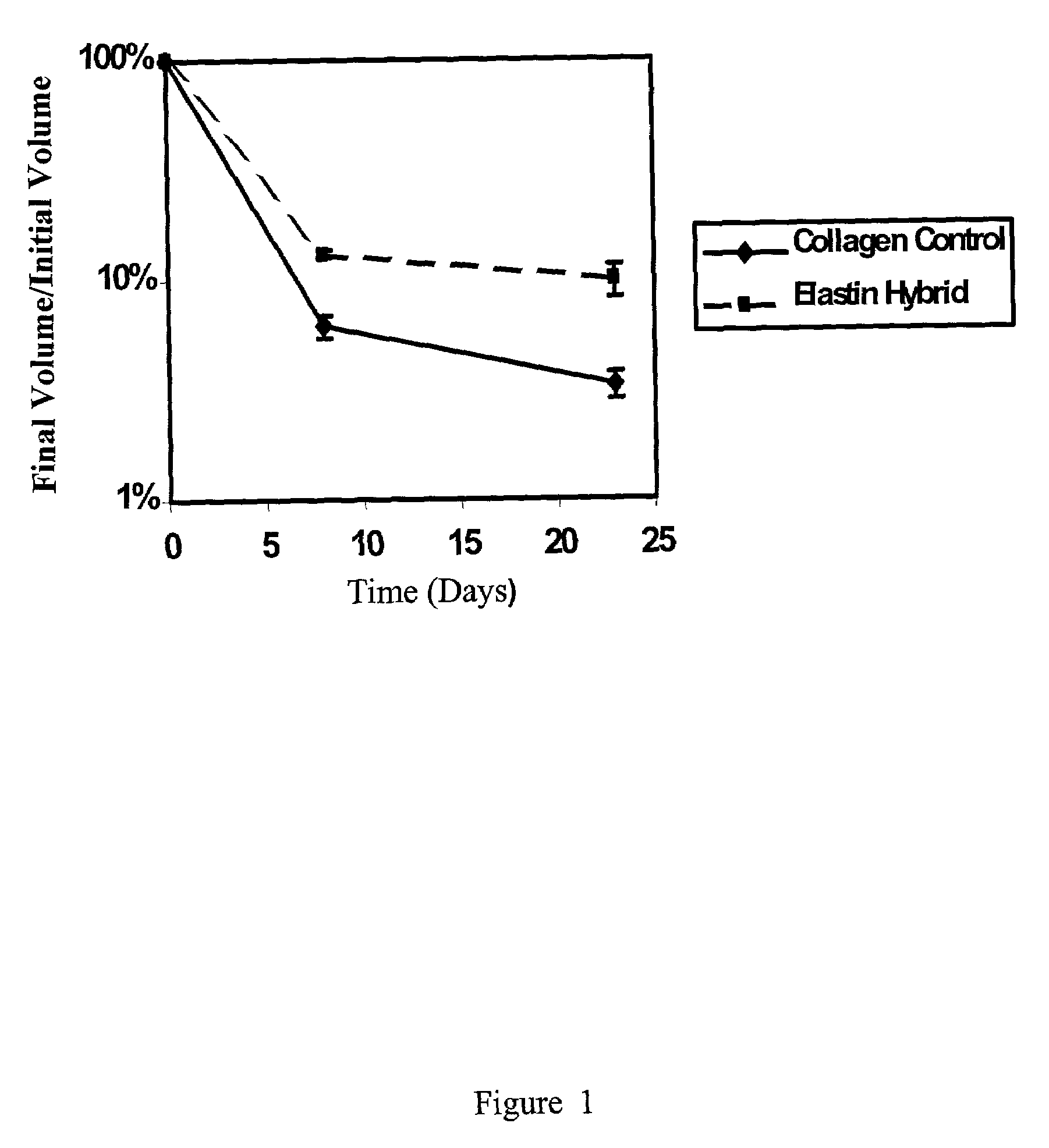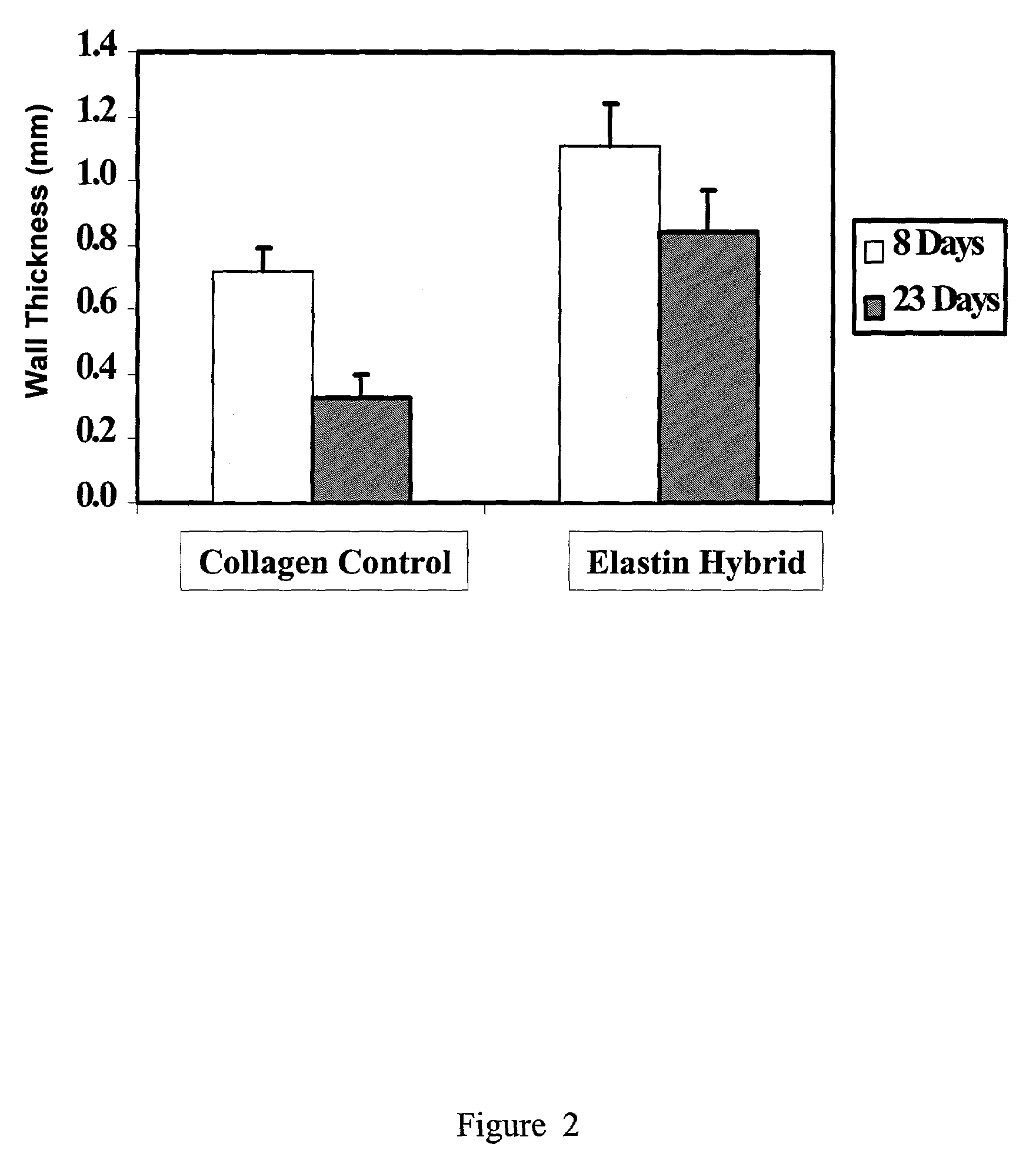Tubular construct for implantation
- Summary
- Abstract
- Description
- Claims
- Application Information
AI Technical Summary
Benefits of technology
Problems solved by technology
Method used
Image
Examples
example 1
Cell Culture
[0075]Several types of eukaryotic cells, including neonatal human dermal fibroblasts (HDFs), the murine NIH-3T3 fibroblast cell line, and rat aortic smooth muscle cells (RASMs) were used to investigate the effects of elastin in vascular grafts. All eukaryotic cells were cultured and maintained under sterile conditions in tissue culture treated dishes and T-flasks. Media changes, subculturing, and other manipulations were conducted in laminar flow Class IIA / B3 biological safety cabinets (Forma Scientific, Marietta, Ohio). Unless indicated, cells were maintained at 5% CO2 and 37° C. in humidified, water-jacketed incubators (Forma Scientific).
[0076]Cell culture medium was selected based on the needs of individual cell types and was replaced every 2–3 days to replenish nutrients and to remove waste products. When cultures became 90–95% confluent cells were trypsinized and split. Following a brief rinse in Hank's Buffered Salt Solution (HBSS) or 0.05% trypsin-0.53 mM ethylene...
example 2
A Collagen Support Structure
[0083]The use of reconstituted collagen as a cell scaffold was first described by Bell et al. in 1979 (Bell, Ivarsson et al. 1979). By 1985, the fabrication techniques had been modified to produce small diameter vascular constructs (Weinberg and Bell 1986). The basic protocol to make standard collagen-based tubular construct is described in this Example.
[0084]Collagen support structures were constructed from acid digested, Type I rat-tail collagen which had been dissolved in 0.02 N acetic acid. The collagen was obtained from Collaborative Biomedical Products (Bedford, Mass.) and typically varied in concentration from 3.49 to 4.30 mg / ml depending on the lot. Neutralizing the collagen solutions with a weak base, such as 0.1 N NaOH, caused the acid-solubilized molecules to spontaneously aggregate to form polymeric chains in a process known as fibrillogenesis. The rate of this reaction is dependent upon both temperature and pH, and components used in the cons...
example 3
Exogenous Elastin Fragments
[0089]Five types of elastins and elastin fragments were purchased from Elastin Products Company, Inc. (EPC, Owensville, Mo.) to investigate the effects of elastin fragments on vascular constructs. Two of the three insoluble elastins studied were procured from bovine neck ligaments. One was purified using the neutral extraction method described by Partridge et al. (EPC, #E60) (Partridge, Davis et al. 1955). Briefly, minced bovine ligamentum nuchae were rinsed in a 1% (w / v) NaCl solution. The samples were treated with a series of autoclave cycles (1 ATM, 45 min / cycle) to remove collagen and mucopolysaccharides followed by ethanol or 50% (v / v) ethanol-ether washes to remove the lipids. These processes were repeated, and ultimately, the samples were milled and filtered using a fine-mesh sieve. The resulting insoluble elastins exhibited alterations in their dye-staining character and adsorptive capacity for proteolytic enzymes compared to alkaline-digested spec...
PUM
| Property | Measurement | Unit |
|---|---|---|
| Composition | aaaaa | aaaaa |
Abstract
Description
Claims
Application Information
 Login to View More
Login to View More - R&D
- Intellectual Property
- Life Sciences
- Materials
- Tech Scout
- Unparalleled Data Quality
- Higher Quality Content
- 60% Fewer Hallucinations
Browse by: Latest US Patents, China's latest patents, Technical Efficacy Thesaurus, Application Domain, Technology Topic, Popular Technical Reports.
© 2025 PatSnap. All rights reserved.Legal|Privacy policy|Modern Slavery Act Transparency Statement|Sitemap|About US| Contact US: help@patsnap.com



